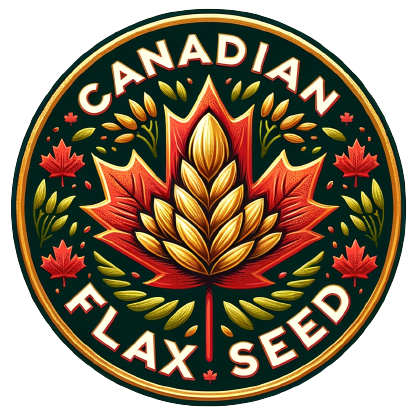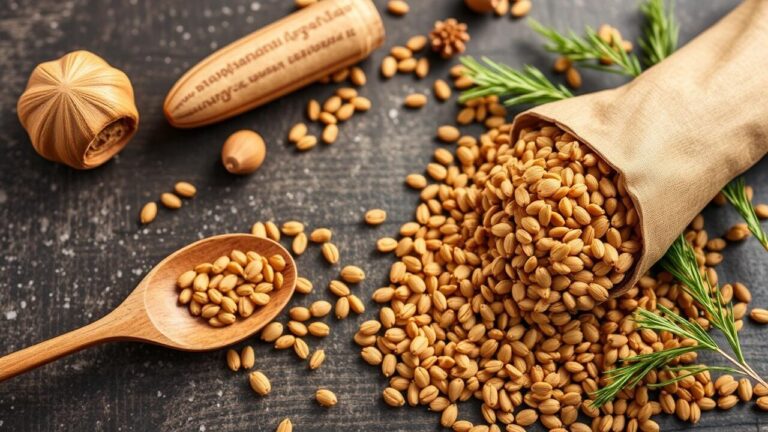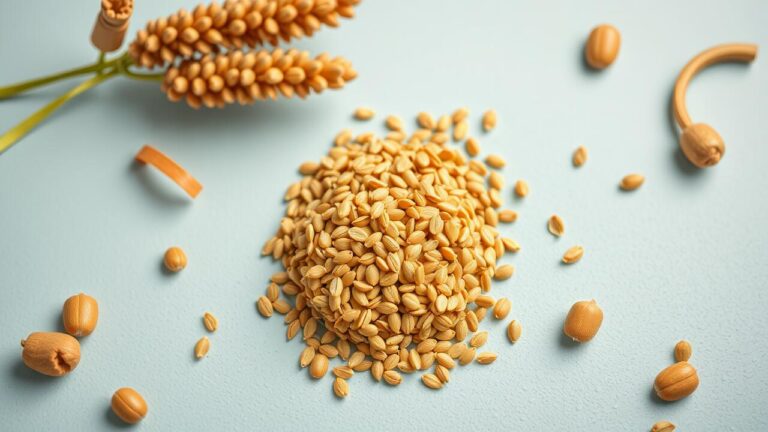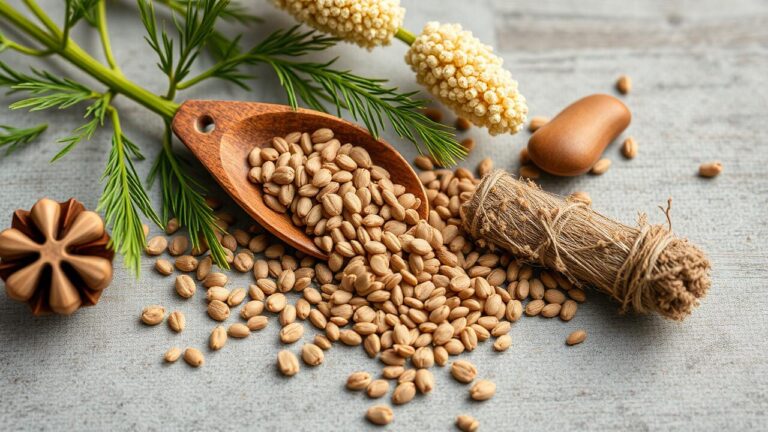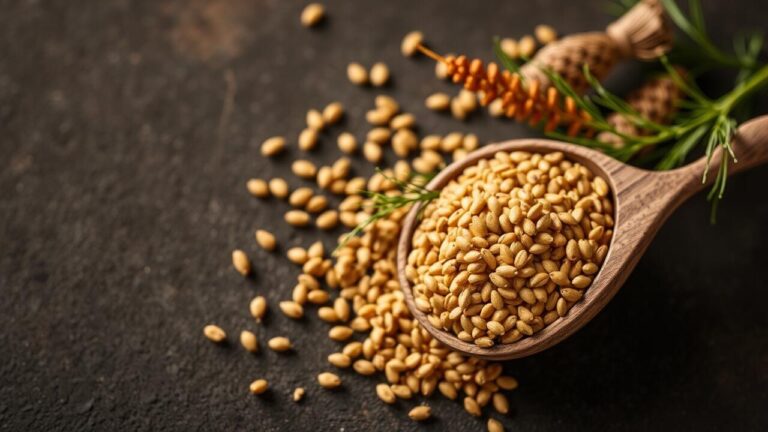Choose Organic Golden Flaxseed
Embarking on the journey of cultivating organic golden flaxseed starts with a careful selection of variety, all while meticulously preparing the soil. The magic lies in creating optimal growing conditions: think well-drained, loamy soils dancing within a pH range of 6.0 to 7.0. Flaxseed revels in cooler climates, making that sweet spot of early spring the perfect time to sow those tiny seeds into the earth’s embrace. Planting them about an inch deep tends to pave the way for successful germination—it’s practically a recipe for growth! But don’t forget—spacing is key; too close together and they’ll be squabbling over precious nutrients.
Now, let’s talk about pest and weed management—a real conundrum in organic farming but oh-so-essential for reaping that bountiful harvest! Enter crop rotation: it’s your secret weapon against soil depletion and pesky invaders lurking among your plants. And then there’s organic mulching, which not only suppresses weeds like a pro but also cradles moisture within the soil like a comforting blanket. Keeping a vigilant eye out for unwelcome guests such as aphids or rust can make all the difference; sometimes you may even need to resort to organic pesticides when things get tricky! Harvest time approaches when those seed pods transition into shades of brown and dryness—a clear signal that it’s go-time for collecting those ripe seeds just waiting to shine!
Best Practices for Cultivation
Successfully nurturing organic golden flaxseed demands an intricate dance with soil quality and the art of crop rotation. Before even thinking about planting, it’s wise to embark on a soil testing adventure—unraveling the mysteries of nutrient levels and pH balance is crucial. Flaxseed flourishes in those well-drained, loamy soils that are generously laced with organic matter, creating a cozy haven for growth. Embracing crop rotation isn’t just beneficial; it’s essential! It breathes life back into tired earth while keeping pesky pests at bay, weaving together a tapestry of sustainable farming practices.
Then there’s the timing—the heartbeat of successful cultivation. Flaxseed usually finds its home in early spring or late summer, depending on where you’re rooted in this vast climatic landscape. Giving plants enough space to breathe not only fosters healthy air circulation but also wards off diseases lurking nearby. Keep your eyes peeled—regular pest monitoring is non-negotiable! Swift action can mean the difference between thriving crops and lost yields. Organic techniques shine here too; think introducing friendly insects or setting traps as clever tactics to manage those unwelcome guests—all without sacrificing our precious environment’s integrity.
The Role of Flaxseed in Sustainable Agriculture
Flaxseed emerges as a crucial player in the realm of sustainable agriculture, its low input demands and remarkable adaptability to a variety of growing conditions making it nothing short of extraordinary. Picture this: as a rotation crop, it disrupts the relentless cycles of pests and diseases—an organic shield that diminishes our dependency on chemical interventions. With roots that plunge deep into the earth, flaxseed not only fortifies soil structure but also stands guard against erosion’s creeping menace. And let’s not overlook its nitrogen-fixing prowess; this little powerhouse boosts soil fertility like few others can, proving itself indispensable for farmers eager to enhance both soil health and their harvests.
But wait! There’s more to flaxseed than meets the eye—it plays an undeniable role in fostering biodiversity, creating havens for beneficial insects and wildlife alike. The cultivation practices surrounding flax typically lean towards minimal tillage—a gentle approach that preserves precious soil integrity and moisture levels. By weaving flaxseed into their crop rotations, farmers unlock pathways to diversification while simultaneously slashing reliance on synthetic fertilizers and pesticides. The grand outcome? A farming system brimming with resilience that rises to meet our soaring demand for eco-friendly agricultural methods!
Environmental Impact and Benefits
Organic golden flaxseed, a marvel in sustainable agriculture, dances lightly upon the earth with its remarkably low environmental footprint. Picture this: it sips water sparingly—far less than many conventional crops that quench their thirst endlessly. And let’s not forget its chameleonic nature; flaxseed flourishes across a tapestry of climates, bending and adapting to whatever conditions it encounters like an expert contortionist.
But wait! The real magic lies in its swift growth cycle—quick as a flash—which allows for rapid crop rotations. This not only fosters biodiversity but also acts as a guardian against soil erosion—a silent hero of the fields.
Now, when you weave flaxseed into your crop rotation tapestry, you’re weaving health back into the soil itself. It enriches nutrient content and enhances structure like a master craftsman shaping clay. Those deep roots? They’re more than just anchors; they combat soil compaction while boosting organic matter levels dramatically! Plus, don’t overlook how growing flaxseed curtails our reliance on synthetic fertilizers and pesticides—less chemical runoff means cleaner waterways nearby.
This synergy nurtures local ecosystems and paves the way for a greener tomorrow—a legacy we can proudly pass down to future generations!
Potential Side Effects of Flaxseed
Flaxseed, that tiny powerhouse hailed for its myriad health perks, also carries a shadowy side—one that shouldn’t be overlooked. Gastrointestinal woes often take center stage in this drama: the high fiber content can stir up quite the ruckus in your belly, leading to discomfort, gas, or bloating, particularly if you dive into flaxseed too eagerly. For those already grappling with digestive issues? Oh boy—these effects might hit harder.
But wait! There’s more lurking beneath the surface. Flaxseed is home to lignans—those intriguing compounds that double as phytoestrogens. This twist can raise red flags for anyone navigating hormone-sensitive conditions; caution is warranted here! And let’s not forget about moderation—the excess of flaxseed could swing open a door to unwanted consequences like an increased risk of bleeding due to its influence on blood clotting pathways. So tread carefully; it’s vital to keep serving sizes in check and have a chat with your healthcare provider before weaving flaxseed into your routine, especially if you’re juggling specific health concerns.
Understanding Recommended Serving Sizes
Flaxseed, a veritable treasure trove of essential nutrients, lends itself effortlessly to our meals. For most folks navigating their nutritional journey, the sweet spot seems to hover around one or two tablespoons of ground flaxseed each day. This modest serving strikes a delightful balance—offering health perks while keeping dietary fiber in check; after all, too much can lead to some rather uncomfortable consequences.
Now, why ground over whole? The answer lies in digestion: the body finds it far easier to break down those little golden nuggets when they’re finely milled. This ensures that all those beneficial nutrients are not just present but readily absorbed into your system!
That said, let’s tread carefully on this path of nutrition. It’s crucial to consider individual health circumstances and unique dietary needs as you figure out your perfect portion size. If you’re grappling with specific gastrointestinal quirks or if flaxseed is a newcomer in your diet repertoire, it might be wise to ease into it—starting small and ramping up gradually as your body gets accustomed. And don’t hesitate! Consulting a healthcare professional can provide invaluable insights tailored just for you—aligning with your personal health aspirations and eating habits like a well-fitted glove!
| Flaxseed Type | Serving Size (tablespoons) | Key Nutrients | Health Benefits |
|---|---|---|---|
| Ground Flaxseed | 1-2 | Omega-3 Fatty Acids, Lignans, Fiber | Improves digestion, Supports heart health, Reduces inflammation |
| Whole Flaxseed | 1-2 | Fiber, Protein | Promotes satiety, Supports digestive health |
| Flaxseed Oil | 1 | Omega-3 Fatty Acids | Supports skin health, Reduces cholesterol levels |
| Flaxseed Meal | 1-2 | Vitamins B1, B6, Magnesium | Enhances nutrient absorption, Aids in weight management |
Popular Recipes Featuring Flaxseed
Incorporating flaxseed into your daily meals can elevate both flavor and nutritional perks to unexpected heights. Picture this: you toss some ground flaxseed into a smoothie, and voilà! You’ve got yourself a drink that’s not just nutty in taste but also packed with omega-3 fatty acids and dietary fiber—what a delightful surprise for your palate!
But wait, there’s more! Baking takes on a whole new dimension when you introduce flaxseed. Imagine adding it to bread, muffins, or pancakes; the result? A glorious boost in health benefits coupled with an enticing texture and an earthy undertone that dances on your taste buds.
Now let’s talk about those vegan recipes! Flaxseed swoops in like a culinary superhero, stepping up as an egg substitute. Simply mix ground flaxseed with water—a magical potion that mimics eggs’ binding abilities perfectly in cookies and cakes alike. And don’t forget salad dressings; they practically beg for a splash of flaxseed oil! This addition imparts a rich nuttiness that beautifully complements whatever ingredients you’re tossing together.
With its remarkable versatility, flaxseed seamlessly weaves itself into various culinary styles while enhancing an array of dishes—you’ll wonder how you ever cooked without it!
Delicious Ways to Enjoy Flaxseed
Flaxseed, oh the wonder of it! This tiny powerhouse can be seamlessly woven into a tapestry of culinary delights to amp up your nutrition game. Picture this: breakfast rolls around, and you decide to sprinkle some ground flaxseed into your warm oatmeal or blend it into a vibrant smoothie. Not only does it transform the texture—giving it that extra oomph—but it also cranks up the fiber and omega-3 fatty acids like nobody’s business.
And let’s not forget about baked goods; they’re simply begging for a touch of flaxseed magic! Tossing some into muffin mixes, bread batters, or pancake recipes brings out a delightful nutty flavor while packing in health benefits that are hard to resist.
Now shift gears to savory dishes—flaxseed shines here too! It elevates salads and dressings with an irresistible crunch. Imagine swirling it into creamy yogurt or scattering it over a colorful fruit bowl—it turns an ordinary snack into something truly satisfying and nutritious.
The beauty of flaxseed lies in its versatility; it’s like a chameleon in the kitchen, ready to adapt itself to countless recipes and elevate your diet effortlessly. Just remember: if you want those health perks at their peak, go for ground flaxseed instead of whole seeds—the body absorbs them much more efficiently, ensuring you reap every last benefit!
Purchasing and Storing Organic Golden Flaxseed
When it comes to choosing organic golden flaxseed, the quest for quality is paramount—think of it as a mission to uncover a treasure trove of freshness and potency. Seek out suppliers who proudly bear the certified organic badge; this isn’t just about labels; it’s about assurance. Scrutinize that packaging! Look for telltale signs of excellence—a freshness date, perhaps, or storage guidelines that whisper secrets on how best to keep those tiny seeds in their prime.
Now, buying in bulk might seem like a savvy move for your wallet, but beware! Those precious seeds need a cool, dark sanctuary to avoid the dreadful fate of premature spoilage. Treat them right!
And then there’s the matter of storage—oh so crucial if you want to preserve every ounce of integrity within those little powerhouses. Whole flaxseeds? They thrive when tucked away in an airtight container nestled in a cool, dry corner for months on end. But once you decide to grind them into powdery goodness? A shift occurs! Suddenly they become susceptible to oxidation—the enemy lurking at every turn—and must be whisked away into the embrace of refrigeration inside another airtight vessel. The key here is simple: only grind what you’ll use immediately! This way you safeguard their beneficial properties against the ravages of time and air exposure—keeping all that nutrient-rich magic intact.
Ensuring Freshness and Quality
When diving into the world of organic golden flaxseed, consumers ought to seize upon freshness and quality as their guiding stars—these elements are vital for unlocking the full treasure trove of its nutritional wonders. Whole seeds reign supreme over their ground counterparts; after all, those precious oils nestled within flaxseed are delicate souls, prone to oxidation once they dare face the open air. So, stash those seeds in airtight containers tucked away in a cool, shadowy nook to safeguard their integrity.
And let’s not forget about packaging dates! A quick glance at these can reveal whether your seeds have been languishing on store shelves for far too long—a key move in maximizing both shelf life and nutrient retention.
Now, if you find yourself leaning toward pre-ground flaxseed instead? Ah, vigilance is essential here. Always check that manufacturing date! Ground flaxseed’s lifespan is significantly shorter—it has a tendency to fade faster than whole seeds. Once you’ve cracked it open? Storing that ground goodness in the refrigerator or freezer becomes paramount to stave off rancidity. This meticulous approach to storage isn’t merely an afterthought; it’s a profound contributor to reaping all the health benefits that organic golden flaxseed has to offer—a delightful boost for any diet out there!
- Always choose whole flaxseed over pre-ground for optimal freshness.
- Store flaxseed in airtight containers to protect it from air and moisture.
- Keep flaxseed in a cool, dark place to extend its shelf life.
- Check packaging dates before purchasing to ensure freshness.
- If using ground flaxseed, opt for freshly ground to retain maximum nutrients.
- Refrigerate or freeze opened ground flaxseed to prevent rancidity.
- Regularly inspect stored flaxseed for any off odors or changes in appearance.
Conclusion
Organic Golden Flaxseed is more than just a simple dietary choice; it’s a multifaceted gem in the realm of nutrition, bursting with health benefits while also championing sustainable agriculture. Picture this: as we cultivate these golden seeds, we’re not just nurturing our bodies; we’re fostering eco-friendly farming practices that prove nutritious food and ecological responsibility can indeed coexist.
Incorporating organic golden flaxseed into your diet isn’t merely about personal wellness—it’s an invitation to engage with larger environmental goals. By embracing this superfood, you may ignite a ripple effect of awareness around sustainable habits and underscore the significance of making healthful choices part of everyday life. So why not dive into this world where well-being meets environmental consciousness? The possibilities are both exciting and plentiful!
